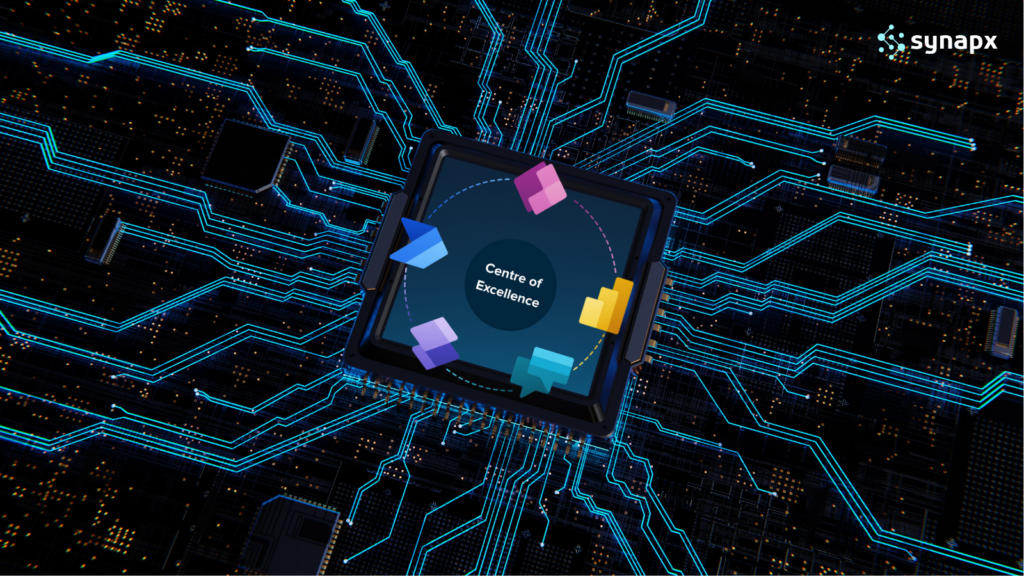In today’s data-driven world, the ability to swiftly interpret and act on information is not just an advantage but a necessity for businesses across the globe. Microsoft, a pioneer in the realm of data technology, has continually evolved its offerings to meet this need, with Power BI leading the charge in transforming raw data into insightful, actionable intelligence.
Now, with the introduction of Microsoft Fabric, the landscape of data visualisation and analytics is poised for another significant leap. But what does this mean for your business, and how do these technologies interplay to revolutionise the way we approach data?
Let’s explore how these powerful tools collectively enhance your data analysis and reporting capabilities. From understanding their core functionalities to unravelling their key differences, we aim to provide a clear picture of how each component contributes to a robust data strategy.
Whether you are a business leader looking to harness the power of data, a data professional eager to stay ahead of the curve, or someone contemplating the value of a Power BI consultant for your organisation’s data journey, this post is designed to guide you through the intricacies of modern data analytics.
Introduction to Microsoft Fabric and Power BI
Microsoft Fabric and Power BI are two distinct yet complementary components within the Microsoft ecosystem, each serving unique roles in data management and analysis.
Microsoft Fabric

Microsoft Fabric is an all-in-one analytics solution. It’s designed to cover a broad spectrum of analytics needs, from data movement and data science to real-time analytics and business intelligence. It integrates various components, including Power BI, Azure Synapse, and Azure Data Factory, into a single environment. This integration facilitates a range of analytics experiences on a shared platform.
Businesses use Microsoft Fabric for complex, large-scale data operations that require integration across multiple analytics domains. It’s ideal for enterprises needing end-to-end analytics solutions, encompassing data engineering, science, warehousing, and real-time analytics.
Power BI:
Power BI is a tool specifically focused on business intelligence. It’s part of the broader Microsoft Power Platform and is designed to help businesses efficiently Visualise their data and share insights across their organisation or embed them in an app or website. It excels in data Visualisation, enabling businesses to create interactive reports and dashboards.
Role within Microsoft Fabric: In the Microsoft Fabric ecosystem, Power BI provides the business intelligence layer, allowing users to Visualise and interact with the data processed and managed within the Fabric platform.
Power BI is used by businesses for creating data Visualisations, generating reports, and performing analytics on data to aid in decision-making. Power BI stands out for its ability to turn volumes of data from various sources into coherent, visually immersive, and interactive insights.
In essence, while Power BI is a leading tool for business intelligence and data Visualisation, Microsoft Fabric provides a more extensive infrastructure for end-to-end data management, advanced analytics, and real-time data processing, which are beyond the scope of Power BI’s capabilities.
Key Differences Between Microsoft Fabric and Power BI
As we navigate the evolving landscape of business intelligence and data analytics, understanding the distinct functionalities and strengths of Microsoft Fabric and Power BI becomes crucial. While both are integral parts of Microsoft’s analytics offering, they serve different purposes and cater to varied needs within an organisation.
What Microsoft Fabric offers
- Comprehensive Data Management: Fabric includes tools for data engineering, data factory, and data warehousing, enabling large-scale data transformation and management, which Power BI doesn’t inherently provide. This ensures that large and varied data sets can be efficiently managed, transformed, and stored, which is crucial for businesses dealing with vast amounts of data.
- Advanced Data Science Capabilities: Fabric allows for building, deploying, and operationalising machine learning models, a feature beyond Power BI’s core functionality. This enables businesses to leverage machine learning for predictive analytics and automated decision-making, enhancing competitiveness and innovation.
- Real-Time Analytics for Observational Data: Fabric has specialised capabilities for real-time analytics, particularly for complex, semi-structured observational data like IoT device outputs, which is not a primary focus of Power BI. This is vital for industries like manufacturing or logistics that rely on IoT devices, as it allows for immediate response and insights from live data streams.
- Unified Data Lake (OneLake): Fabric offers OneLake, a unified data storage solution that simplifies data management across the enterprise, something Power BI doesn’t offer by itself. It simplifies data storage and access, reducing the complexity and costs associated with managing multiple data storage solutions.
- Centralised Administration and Governance: Fabric ensures centralised administration and consistent governance and compliance across all its services, including Power BI, which is more extensive than what Power BI offers standalone. It ensures data security and compliance, crucial for regulatory adherence and efficient management of data access and use.
What Power BI Offers
- Interactive Data Visualisation: Power BI excels in creating interactive charts, graphs, and dashboards, which is not a primary feature of Fabric. This facilitates easy understanding of complex data, aiding in decision-making and communication of insights across the organisation.
- Self-Service Business Intelligence: It allows users with minimal technical expertise to create and share insights from data, empowering non-technical users to generate insights, democratising data analysis and reducing reliance on IT specialists.
- Extensive Data Connectivity to BI-Specific Sources: Power BI can connect to a wide range of data sources specifically for business intelligence purposes. This allows businesses to integrate and analyse data from diverse sources, crucial for a comprehensive view of business operations.
- In-built Data Analysis Expressions (DAX) Language: For creating custom calculations in Power BI reports. It provides advanced analytical capabilities, enabling users to create sophisticated calculations and analytics tailored to specific business needs.
When to Use Each Microsoft Fabric vs Power BI
Use Microsoft Fabric when your need involves comprehensive data management, handling large-scale data, integrating advanced analytics or machine learning models, and when dealing with real-time data processing.
Use Power BI for creating visual representations of data, conducting business intelligence analysis, and when the primary need is to generate interactive reports and dashboards for decision-making.

In a business context, Microsoft Fabric is more suitable for backend data operations and infrastructure management, while Power BI is ideal for front-end data Visualisation and reporting.
Exploring the Integration of Microsoft Fabric with Power BI
Microsoft Fabric integrates with Power BI through its comprehensive data management and analytics infrastructure, enhancing the capabilities of Power BI in several ways.
Fabric’s unified data environment (OneLake) provides a centralised data repository which Power BI can access for visualisation and analysis. This allows Power BI to draw from a more extensive and diverse set of data sources managed by Fabric.
With Fabric’s advanced data science and real-time analytics features, Power BI users can incorporate more sophisticated analytics, like machine learning insights and real-time data streams, into their reports and dashboards. The integration ensures that Power BI adheres to the centralised governance and security protocols established in Fabric. This unified approach to data management and compliance extends to the visualisations and reports created in Power BI.
Power BI benefits from the shared SaaS foundation of Fabric, offering users a familiar and consistent interface across different data analytics tasks. By integrating with Fabric, Power BI becomes a more powerful tool in the context of a larger, more complex data ecosystem, capable of delivering deeper insights and supporting more comprehensive data management strategies.
Benefits of Combining Microsoft Fabric with Power BI
The integration of Microsoft Fabric with Power BI opens up a world of possibilities, combining Fabric’s robust data management with Power BI’s advanced visualisation capabilities. This powerful amalgamation offers unique benefits that can transform the way organisations handle and interpret their data. Whether you’re in retail, healthcare, finance, e-commerce, or any data-driven sector, understanding these benefits can redefine your approach to data management and analytics.
- Leveraging Fabric’s comprehensive data management and Power BI’s Visualisation tools allows for deeper, more actionable insights. For instance, a retail company can leverage this integration to combine sales data, customer feedback, and supply chain information, all managed in Fabric, to create comprehensive dashboards in Power BI. These insights can reveal buying trends, inventory needs, and customer preferences, leading to better stock management and targeted marketing campaigns. The depth of insight comes from the breadth of data sources and advanced analytics capabilities, enabling a holistic view of the business.
- Unified data management and analysis streamline workflows, improving efficiency and reducing the complexity of handling large data sets. Consider a healthcare provider managing vast patient records, research data, and operational information. Fabric’s data management capabilities can centralise this data, while Power BI can be used to visualise patient outcomes or operational efficiency. This streamlining leads to quicker, more efficient data processing and reporting, reducing the time from data collection to actionable insights.
- Access to real-time data and advanced analytics enhances the organisation’s ability to make informed, timely decisions. In a financial services firm, real-time market data and customer transaction histories can be analysed using Fabric’s real-time analytics, with trends and patterns visualised in Power BI. This enables rapid, data-driven decision-making in response to market changes, enhancing the firm’s agility and competitive edge.
- The combination supports scalable and flexible data strategies, accommodating growth and evolving business needs. A growing e-commerce business can benefit from the scalability of Fabric to handle increasing volumes of transactional and customer data, while Power BI’s flexibility allows for customised reporting as the business evolves. This adaptability ensures that the business’s data infrastructure grows with its needs.
- Centralised governance ensures data security and compliance, crucial in a data-driven environment. A multinational corporation must comply with various data privacy regulations. Fabric’s centralised data governance ensures compliance across all departments, while Power BI’s integration maintains these standards in data reporting and Visualisation. This unified approach to governance and security minimises the risk of data breaches and non-compliance penalties.
How Microsoft Fabric Elevates Power BI’s Capabilities
In the realm of data management and visualisation, the integration of Microsoft Fabric with Power BI represents a significant enhancement in Power BI’s capabilities. Renowned for its effective data visualization, Power BI’s functionality is greatly expanded when combined with Microsoft Fabric’s comprehensive data management tools.
While Power BI has many connectors, Fabric’s data management capabilities enable the consolidation and pre-processing of data from these diverse sources into a unified data lake (OneLake). This centralised data repository can be directly accessed by Power BI, making it easier to pull in and visualise a wider array of data, including those that might require extensive pre-processing or are not directly connectable via Power BI.
Fabric’s data engineering tools help in cleaning, transforming, and structuring data before it’s used in Power BI. This preprocessing improves the data’s quality, ensuring that Visualisations in Power BI are based on accurate and reliable data. Fabric’s integration with advanced analytics tools, such as machine learning and real-time analytics, allows Power BI to access and Visualise these sophisticated data sets. Power BI can then present this complex data, like predictive models or real-time streams, in an easily digestible format.
The data engineering and transformation capabilities within Fabric streamline the data preparation process. This means that by the time data reaches Power BI for visualisation, it is already in a format that is easier to work with, reducing the time and effort required to create reports and dashboards.
Fabric’s centralised governance ensures that the data managed within its ecosystem, and subsequently accessed by Power BI, adheres to organisational and regulatory standards. This integration means that data Visualisations and reports generated in Power BI are automatically compliant with these standards.
Why Choose a Power BI Consultant for Your Microsoft Fabric Integration
In today’s data-centric business environment, effectively integrating Microsoft Fabric with Power BI is pivotal for leveraging the full potential of your data analytics. While IT specialists offer a broad understanding, the specialised expertise of a Power BI consultant can significantly enhance the efficiency and effectiveness of this integration.
A Power BI consultant can tailor Power BI solutions specifically for your business needs and optimise them for best performance. They will evaluate your existing processes and provide recommendations on how to optimise your data management and analysis. They would assess your current data infrastructure, workflows, and usage of analytical tools (like Power BI), and then identify areas for improvement. This could include streamlining data collection and processing, enhancing data quality, recommending better integration methods, and suggesting more effective ways to utilise data analytics for business decision-making. Their expertise allows for a comprehensive review and tailored solutions to improve data optimisation in your organization.

Integrating with Microsoft Fabric can be complex due to its comprehensive nature, involving various components like data lakes, data engineering, and advanced analytics. Without expert guidance, there’s a risk of the technology not aligning well with specific business goals. A Power BI consultant helps navigate these complexities, ensuring effective implementation and alignment with business needs.
Although consultants can be expensive, the long-term gains and costs saved when troubleshooting or resolving mistakes during set-up are far greater. A consultant can quickly identify and resolve issues that might take much longer to figure out without their help. Slow response to data-driven insights could mean missing out on key business opportunities. Prolonged issues may eventually require more resources to fix than if addressed promptly by a consultant.
Beyond technical know-how, consultants can offer strategic advice on how to best leverage Power BI and Microsoft Fabric for business insights and decision-making. They can guide you in using the advanced features of both, which might not be fully covered in online tutorials.
Engaging a Power BI consultant to integrate Microsoft Fabric into your business processes is more than just a technical decision; it’s a strategic investment in your organisation’s data-driven future. Their specialised expertise not only ensures a seamless and effective integration but also brings long-term value through optimised performance, strategic business insights, and the avoidance of costly mistakes.
Conclusion
The integration of Microsoft Fabric and Power BI represents a significant advancement in data analytics and visualisation for businesses. Microsoft Fabric’s comprehensive data management, combined with Power BI’s robust visualisation tools, provides a unified solution for advanced data processing and analysis. This combination allows for deeper insights, streamlined workflows, and informed, timely decision-making. The use of Microsoft Fabric enhances Power BI’s capabilities, offering a scalable and flexible approach to data strategy, while also ensuring centralised governance for data security and compliance. Utilising a Power BI consultant for this integration can optimize implementation, aligning technology with business goals and maximising the potential of data-driven strategies.



